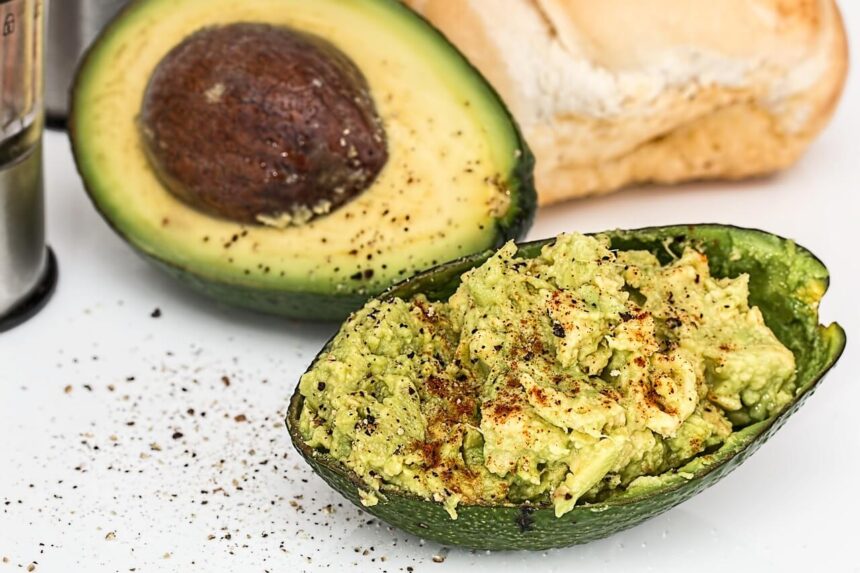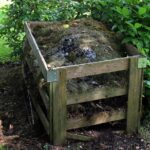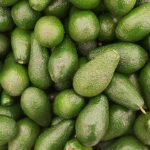These are the pests and diseases that affect Avocado farming in Kenya.
1. Crystal spider – Oligonychus Perseae
A Crystal spider is a mite that constitutes one of the most critical pests in avocado farming. These adults, of a greenish-yellow color, have an oval-shaped body and a pointed abdomen, while the eggs have a spherical shape and the color is a paler yellow.
It is possible to distinguish between five stages of development: egg, larva, protonymph, deutonymph, and adult, each of which may be found simultaneously in the same nest.
From the egg phase to the adult phase, the length of its cycle varies based on temperature.
The feeding process is carried out in colonies or nests, protected under a dense spider web, arranged near the central nerve and the secondary ones on the leaves underside. Because of this, a series of discolorations form.
They are brown in color and circular in shape, which you can see in the beam if they are very severe.
These leaves will eventually fall off, exposing the fruits and causing an increased risk of burns from continued exposure to the sun.
Also read: Blossom End Rot in Tomatoes: Causes and Treatment
2. Mealybug – Protopulvinaria Pyriformis
These are species of homopter that are easily recognizable thanks to adults’ characteristic appearance. This is similar to a flat shield, heart-shaped, with brown tones on its surface, with some violet hue.
From them emerge the nymphs, which after two days approximately, go outside, looking at the underside of the leaves, in areas near the central nerve.
After a while, the nymphs transform into adults. There is a general weakening of the plant due to sap suction.
3. Mealybug of the avocado – Nipaecoccus Nipae
Pseudococcal polyphagous, with sexual dimorphism, whose females have an elongated and oval shape, with pinkish or maroon hues, with a waxy, whitish-colored series of cones on its surface, which give it a unique appearance.
Due to these bumps on its surface, it is also known as the mealybug man.
Males are more rectangular in shape and smaller in size than females. It leads to a weakening of the plant, and the appearance of sooty mold (bold), both in the leaves and in the fruits, and can even cause the tree’s death in those younger plants in a more particular way.
The presence of molasses also generates an attraction to ants, which facilitates the spread of the pest, preventing the action of natural enemies, that is,
4. Snowy mealybug – Aulacaspis Tubercularis
Hemiptera owes its name to the whitish coloration that male colonies present.
From this data, it can be deduced that there is a marked sexual dimorphism so that the coat of the males is much more elongated and has some slits, arranged longitudinally, white and parallel to the body.
On the other hand, the female is circular and has a flat, whitish shield covering her entire body.
Also, the females are not grouped but are scattered throughout the leaves and fruits.
They mainly concentrate on the oldest leaves, especially those in the tree’s shadiest points.
There is a yellowing of the leaves, in which the affected areas die, and the leaves may prematurely drop if the attack is of high intensity.
The fruits cause discolorations in the attacked areas, which leads to alterations in the ripening process and a depreciation of their commercial value.
5. Trips – Heliothrips Haemorrhoidalis
insects belonged to the order Thysanoptera, of small size, which in the adult state have shades with changes in the abdomen, from yellow to finally black and rarely carried out a flight, which is why it is established that they are slow in all their stages.
As a general rule, the presence of thrips is associated with vegetative sprouting, flowering, and fruit tying.
Likewise, its population dynamics are influenced by the climate, management practices, and crops found in neighboring areas.
During the winter, this species remains as an egg, from which a larva will emerge approximately in early February.
These eggs are individually arranged on the top, the leaves underside, or inserted into the fruit.
The damage caused by this pest is observed in the foliage, where a series of discolorations begin to appear along the central nerve of the leaves.
Subsequently, they suffer chlorosis, accompanied by brittle scars. The damage is related to their lengthening and deformation in the most tender stems.
If the attack occurs during flowering, the flowers abort, leading to decreased production levels. Damage to the fruit affects only its aesthetic quality.
6. Avocado sadness – Phytophthora spp.
A genus that includes different species, all oomycetes, which produce wilting and can remain in the soil for several years, in the absence of a host, especially in the most superficial layers, on organic substrates as plant remains and humus.
The factors that most favor its development are high temperatures and excess water.
It is located in the infected roots, tubers, bulbs, or ground in different cold seasons.
Its transmission is due to wind and rain, causing it to fall to the ground, where it spreads. It penetrates the host from unprotected superficial wounds or natural openings.
The symptoms are concentrated in the neck, and the primary roots, which rot and the bark, become dehydrated, thus taking on a dark color.
The disease progresses with relative ease, and the trees that suffer from it present generalized weakening, leaf fall, wilt, small caliber fruits, poor maturation, collapse, and even death. All these symptoms depend on the severity and level of involvement.
7. Verticilosis – Verticillium sp.
A disease caused by the pathogenic fungus’s action gives it its name, which leads to discoloration and coiling on the leaves. It can end up causing the tree’s death since it gradually dries its branches.
Its transmission can occur between trees of the same species or by contagion through a host, such as adventitious species and other species grown in neighboring areas.
The fungus infects the tree through the roots, taking advantage of lesions on its surface caused by work carried out by the farmer or by the action of other living things, such as insects or nematodes.
Once it has reached the interior, the fungus mycelium spreads relatively quickly through the vascular system, reacting to the pathogen’s viscous substances, which plug the conductive vessels.
8. Scab Sphaceloma Perseae
A pathogenic fungus with variable colonies, greyish white to grey, darkened over time. It mainly attacks the fruit, leaves, and the youngest branches of the tree.
A brown lesions appear in the fruits, similar to the cork, which can end up joining, covering the entire fruit.
The fungus’ entry into the fruit occurs associated with the attack of insects, rodents, or blows. However, generally, the damage occurs only on the fruit’s surface, on the pericarp, and not on the pulp.
Clearly defined individual spots appear on the leaves, leading to leaf malformations when the attack is very severe.
Elongated and slightly prominent lesions appear on the branches. Requires conditions of high relative humidity,
9. Apical necrosis – Family Botryosphaeriaceae
groups numerous species of ascomycetes fungi, which have similarities at the morphological level, by which they can only be differentiated by applying molecular biology techniques.
The most significant symptoms of this pathology are descending death or descending necrosis of the branches’ branches and chancre.
In the former, the branches become necrotic from the apex, and little by little, the necrosis progresses downward, causing the leaves and inflorescences to dry up.
In the cankers, an exudation appears, which turns into a whitish-yellowish powder, all of it joined to a cracked bark, which can also have a dark color and even sink.
Finally, it should be noted the rot of the fruit, which does not begin to distinguish until after harvest, is when the fruits start to ripen post-harvest.
Sometimes the trees can remain asymptomatic for long periods without the characteristic symptoms of this pathology appearing.
10. Gall or tumor of the neck – Agrobacterium tumefaciens
Proteobacteria, also called Rhizobium radiobacter, triggers the formation of tumors known as galls, which grow mainly in the area of union between the roots and the stem, that is, in the neck.
The pathogen reaches the minor wounds through which it is introduced, guided by the plant expels’ phenols.
It can survive in the soil as a saprophytic organism for years, feeding on different decomposing materials.
It ceases its activity in the autumn and winter, resuming when conditions are more favorable.
This disease’s symptomatology is mistaken for damage from root diseases caused by fungi, such as Armillaria mellea, or due to nutritional deficiencies. The only external symptoms that you can see are around the neck.
The progressive weakening of the tree is related to the difficulty of circulation of the sap, which can even cause the plant’s death.
The essential losses occur in nurseries since young plants are much more vulnerable.







